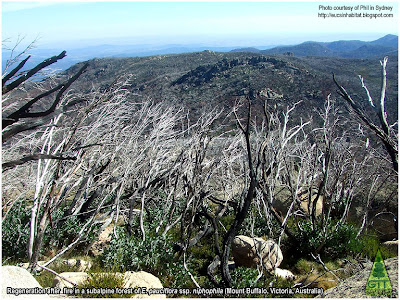Eucalyptus help protect soil against erosion after fire events
Or why setting the weeds on fire will just guarantee tree resurrection
Gustavo Iglesias Trabado 
GIT Forestry Consulting - Consultoría y Servicios de Ingeniería Agroforestal - www.git-forestry.com - EUCALYPTOLOGICS

GIT Forestry Consulting - Consultoría y Servicios de Ingeniería Agroforestal - www.git-forestry.com - EUCALYPTOLOGICS
We have previously seen images of natural regeneration in E. delegatensis, E. obliqua, E. globulus, E. nitens, E. blakelyi, E. nicholii and E. gunnii in which regrowth was present from lignotuber or axillary buds after the removal af the aerial part of the trees. Today we will see one of the natural equivalents to coppice growth after timber harvest, which is vegetative regeneration after fire.
 Fig. 1: Snow Gums regrowing after fire in the Victorian Alps (Australia)
Fig. 1: Snow Gums regrowing after fire in the Victorian Alps (Australia)(Photo courtesy of Phil in Sydney's Blog "Eucalypts In Habitat")
This response in different eucalypt species is the result of adaptation to changes in their natural Australian habitat during millenia, and particularly to different degrees of natural selection pressure caused by relatively frequent forestry fire events. After the loss of their aerial part by fire, only the most vigorous coppicer specimens become dominant trees and, if free from further fire damage in the short term, are able to produce flowers, cross pollinate and produce seed for a next generation. They compete among themselves, with other quick growing surrounding vegetation and also, if reproductively mature before being charred, with a new cohort of seedlings rapidly growing on short-term fertile soils rich in nutrients from ash.
In Eucalyptus forestry plantations overseas those species, provenances and races introduced from areas where evolution favoured vigorous coppicers show a similar behaviour. Even if the aerial part is totally killed, some months later new regrowth shows up in Eucalyptus trees and proves casualty rate is relatively low. Other types of tree covers, especially conifers, are a total loss instead. Intact eucalypt root systems are able to hold denuded soil from the adverse effect of erosion, which in areas of noticeable slope is the major catastrophic risk after a fire.
But managed plantations are normally grown in short rotation cycles and at quite close spacings, so peak seed production is not yet achieved even if reproductive maturity is reached, and tree crowns are small. Only overgrown trees and extramature stands do release seed in sufficient amounts for a noticeable colonisation of bare soils after fires but in most cases where coppice is vigorous enough these are quickly dominated by the fastest growing survivors, able to use available resources more efficiently with their already formed root systems, the same that can offer the only noticeable protection to soil.
Eucalyptus plantations after fire
In Eucalyptus forestry plantations overseas those species, provenances and races introduced from areas where evolution favoured vigorous coppicers show a similar behaviour. Even if the aerial part is totally killed, some months later new regrowth shows up in Eucalyptus trees and proves casualty rate is relatively low. Other types of tree covers, especially conifers, are a total loss instead. Intact eucalypt root systems are able to hold denuded soil from the adverse effect of erosion, which in areas of noticeable slope is the major catastrophic risk after a fire.
But managed plantations are normally grown in short rotation cycles and at quite close spacings, so peak seed production is not yet achieved even if reproductive maturity is reached, and tree crowns are small. Only overgrown trees and extramature stands do release seed in sufficient amounts for a noticeable colonisation of bare soils after fires but in most cases where coppice is vigorous enough these are quickly dominated by the fastest growing survivors, able to use available resources more efficiently with their already formed root systems, the same that can offer the only noticeable protection to soil.
 Fig. 2: Example of vegetative regeneration 1 year after an unique forest fire event in an E. globulus plantation: +90% of charred stumps show new growth
Fig. 2: Example of vegetative regeneration 1 year after an unique forest fire event in an E. globulus plantation: +90% of charred stumps show new growthHowever even these hard to kill plants have limits. Repeated fire events affecting young regrowth can greatly diminish their resilience and the number of survivor stumps declines some months later. With ability to coppice more than a dozen times, species like E. globulus cannot be erradicated by fire. But their weakening can reduce their ability to retain soil considerably. Repeated fire events anihilate other quick colonising vegetation and destroy the fertile layers of top soil, impoverishing the diversity of a subsequent vegetation cover, in case all soil is not removed earlier along the natural drainage lines and makes restoration impossible.
 Fig. 3: Example of regeneration 1 year after two sucessive forest fire events in an E. globulus plantation: 50% of stumps show new growth. Note the very exposed soil compared to the previous.
Fig. 3: Example of regeneration 1 year after two sucessive forest fire events in an E. globulus plantation: 50% of stumps show new growth. Note the very exposed soil compared to the previous.Catastrophic events, forestry fires are the enemy of trees, animals and human beings. Against their pernicious effects Eucalyptus can offer some stubborn survival and some soil protection where other types of trees would be simply wiped out. However this help cannot be infinite. Well managed tree plantations, no matter the species, are not the main vegetation cover posing the higher risk of forest fires. But when catastrophe happens, some types of Eucalyptus offer their protection and can prevent further catastrophes as soil denudation and desertification.
Yet another irony, we had a trip from the myth of "Eucalyptus being the trees causing forest fires" to the fact of "Eucalyptus being the trees protecting soil after forest fires".
© 2007 Gustavo Iglesias Trabado. Please contact us if you want to use all or part of this text and photography elsewhere. We like to share, but we do not like rudeness.
Yet another irony, we had a trip from the myth of "Eucalyptus being the trees causing forest fires" to the fact of "Eucalyptus being the trees protecting soil after forest fires".
![]() Subscribe to receive EUCALYPTOLOGICS via RSS
Subscribe to receive EUCALYPTOLOGICS via RSS
© 2007 Gustavo Iglesias Trabado. Please contact us if you want to use all or part of this text and photography elsewhere. We like to share, but we do not like rudeness.




































![Validate my Atom 1.0 feed [Valid Atom 1.0]](http://gus.iglesias.googlepages.com/valid-atom.png)

















